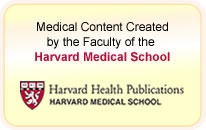
Conditions in Depth
This page contains the basic information about High Cholesterol (Hypercholesterolemia) .
Return to the High Cholesterol (Hypercholesterolemia) Main Condition Center
What Is It?
Cholesterol is a fatty substance that occurs naturally in the body. It performs several vital functions. It is needed to make the walls surrounding the body's cells and is the basic material that is converted to certain hormones. Your body makes all the cholesterol you need. You need only a small amount of fat in your diet to make enough cholesterol to stay healthy.
The fat and cholesterol you eat are absorbed in the intestine and transported to the liver. The liver converts fat into cholesterol, and releases cholesterol into the bloodstream. There are two main types of cholesterol: low-density lipoprotein (LDL) cholesterol (the "bad" cholesterol) and high-density lipoprotein (HDL) cholesterol (the "good" cholesterol).
High levels of LDL cholesterol are linked to atherosclerosis, which is the accumulation of cholesterol-rich fatty deposits in arteries. This can cause arteries to narrow or become blocked, slowing or stopping the flow of blood to vital organs, especially the heart and brain. Atherosclerosis affecting the heart is called coronary artery disease, and it can cause a heart attack. When atherosclerosis blocks arteries that supply blood to the brain, it can cause a stroke.
High levels of HDL cholesterol actually protect against heart attacks and strokes by removing cholesterol from the arteries and bringing it back to the liver.
Because high cholesterol levels can cause atherosclerosis, doctors recommend that people keep their cholesterol levels within a specific range. In general, adults older than 20 should try to keep their total cholesterol level below 200 milligrams per deciliter.
For a more precise assessment of the risk of atherosclerosis, your LDL cholesterol should be checked. According to guidelines established by the government-sponsored National Cholesterol Education Program, the desirable level for LDL cholesterol depends on whether or not a person already has a disease caused by atherosclerosis or diabetes or other risk factors for coronary artery disease. In addition to a high LDL cholesterol level and diabetes, risk factors for coronary artery disease include:
-
Being a male older than 45
-
Being a female older than 55
-
Being a female with premature menopause
-
Having a family history of premature coronary artery disease (a father or brother younger than 55 with coronary artery disease or a mother or sister younger than 65 with coronary artery disease)
-
Smoking cigarettes
-
Having high blood pressure
-
Not having enough good cholesterol (high density lipoprotein or HDL)
If you have coronary artery disease, peripheral arterial disease or have had a stroke from atherosclerosis, your LDL cholesterol should be 70 milligrams per deciliter or less.
The more risk factors you have, the lower your target LDL cholesterol should be. In general, an LDL cholesterol level of less than 100 is best, but less than 130 may be acceptable for people with few or no risk factors.
Your level of HDL cholesterol is also very important. People with levels below 40 milligrams per deciliter are more likely to develop atherosclerosis, heart disease and stroke. Levels of HDL cholesterol above 60 milligrams per deciliter are associated with less atherosclerosis and are thought to help protect against heart disease and stroke.
From Health A-Z, Harvard Health Publications. Copyright 2006 by the President and Fellows of Harvard College. All rights reserved. Written permission is required to reproduce, in any manner, in whole or in part, the material contained herein. To make a reprint request, contact Harvard Health Publications. Used with permission of StayWell.